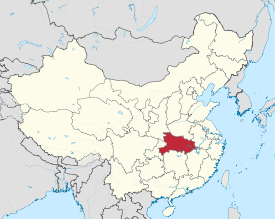Hubei
|
Hubei Province 湖北省 |
|
|---|---|
| Province | |
| Name transcription(s) | |
| • Chinese | 湖北省 (Húběi Shěng) |
| • Abbreviation | (pinyin: È) |
 Map showing the location of Hubei Province |
|
| Coordinates: 31°12′N 112°18′E / 31.2°N 112.3°ECoordinates: 31°12′N 112°18′E / 31.2°N 112.3°E | |
| Capital (and largest city) |
Wuhan |
| Divisions | 13 prefectures, 102 counties, 1235 townships |
| Government | |
| • Secretary | Jiang Chaoliang |
| • Governor | Wang Xiaodong (acting) |
| Area | |
| • Total | 185,900 km2 (71,800 sq mi) |
| Area rank | 13th |
| Population (2015) | |
| • Total | 58,500,000 |
| • Rank | 9th |
| • Density | 310/km2 (820/sq mi) |
| • Density rank | 12th |
| Demographics | |
| • Ethnic composition |
Han: 95.6% Tujia: 3.7% Miao: 0.4% |
| • Languages and dialects | Southwestern Mandarin, Jianghuai Mandarin, Gan |
| ISO 3166 code | CN-42 |
| GDP (2016) |
CNY 3.23 trillion US$ 486.34 billion (7th) |
| • per capita |
CNY 55,210 US$ 8,314 (14th) |
| HDI (2010) | 0.696 (medium) (13th) |
| Website |
www.hubei.gov.cn (Simplified Chinese) |
| Hubei | |||||||||||||||||||||||||||||||

"Hubei" in Chinese characters
|
|||||||||||||||||||||||||||||||
| Chinese | 湖北 | ||||||||||||||||||||||||||||||
|---|---|---|---|---|---|---|---|---|---|---|---|---|---|---|---|---|---|---|---|---|---|---|---|---|---|---|---|---|---|---|---|
| Postal | Hupeh | ||||||||||||||||||||||||||||||
| Literal meaning | "North of the Lake [Dòngtíng]" | ||||||||||||||||||||||||||||||
|
|||||||||||||||||||||||||||||||
| Transcriptions | |
|---|---|
| Standard Mandarin | |
| Hanyu Pinyin | Húběi |
| Bopomofo | ㄏㄨˊ ㄅㄟˇ |
| Gwoyeu Romatzyh | Hwubeei |
| Wade–Giles | Hu2-pei3 |
| IPA | [xǔpèi̯] |
| Wu | |
| Romanization | Wu入 poh平 |
| Yue: Cantonese | |
| Yale Romanization | Wùh-bāk |
| Jyutping | Wu4-bak1 |
| Southern Min | |
| Hokkien POJ | Ô͘-pak |
| Tâi-lô | Ôo-pak |
Hubei (Chinese: 湖北) is a province of the People's Republic of China, located in the Central China region. The name of the province means "north of the lake", referring to its position north of Dongting Lake. The provincial capital is Wuhan, a major transportation thoroughfare and the political, cultural, and economic hub of Central China.
Hubei is officially abbreviated to "" (È), an ancient name associated with the eastern part of the province since the Qin dynasty, while a popular name for Hubei is "" (Chǔ), after the powerful State of Chu that existed here during the Eastern Zhou dynasty. It borders Henan to the north, Anhui to the east, Jiangxi to the southeast, Hunan to the south, Chongqing to the west, and Shaanxi to the northwest. The high-profile Three Gorges Dam is located at Yichang, in the west of the province.
The Hubei region was home to sophisticated Neolithic cultures. By the Spring and Autumn period (770–476 BC), the territory of today's Hubei was part of the powerful State of Chu. Chu was nominally a tributary state of the Zhou dynasty, and it was itself an extension of the Chinese civilization that had emerged some centuries before in the north; but it was also a culturally unique blend of northern and southern culture, and was a powerful state that held onto much of the middle and lower Yangtze River, with power extending northwards into the North China Plain.
...
Wikipedia
